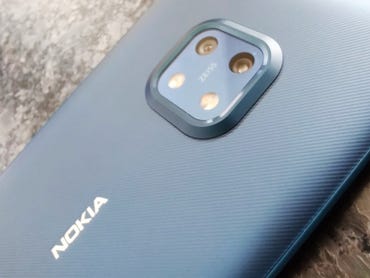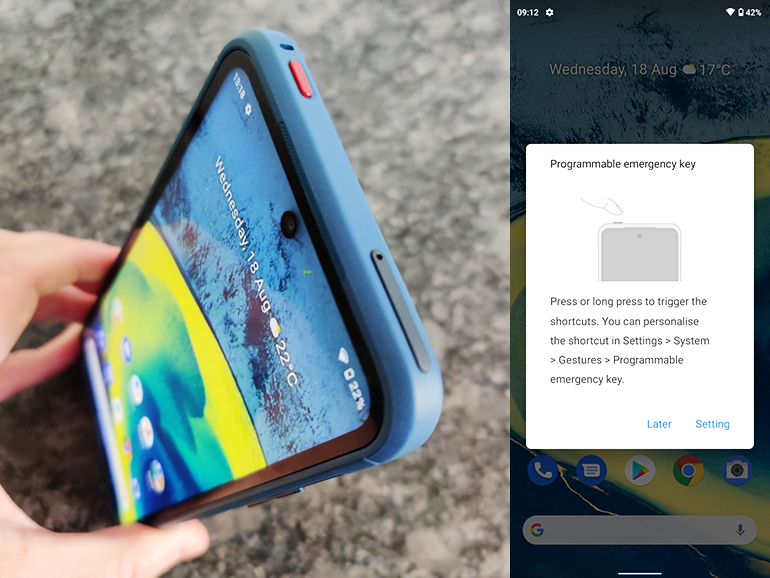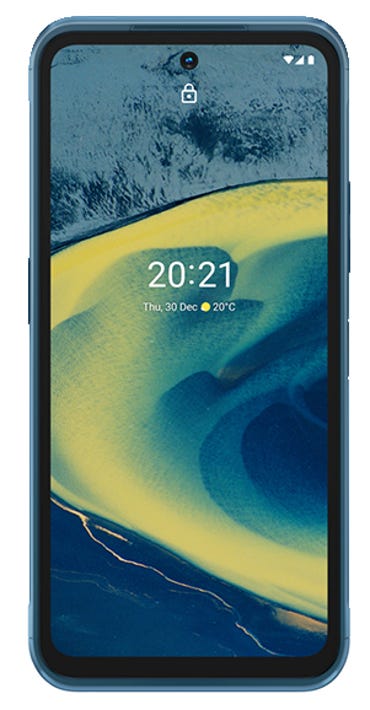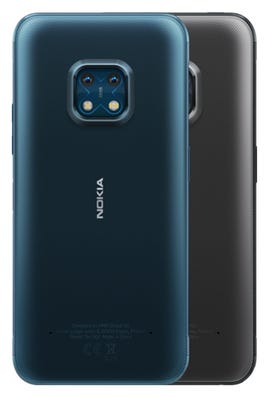Nokia XR20 review: A rugged and reasonably priced mid-range 5G phone Review | ZDNet
Rugged phones tend to be produced by specialist handset makers, and are designed for use in environments where they’re likely to get bashed about, dropped or otherwise mistreated. They may be tough, but the specifications can be disappointing. Some of us want a phone that’s solid enough to cope with challenging use cases, without looking too ‘industrial’ and also packing good specifications.
Nokia’s solution is the XR20, which also comes with four years of security updates and three years of OS upgrades. The entry-level variant, with 4GB of RAM and 64GB of internal storage, costs £399.99. Pay £50 more and you get 6GB of RAM, while another £50 adds 128GB of storage. My review unit was the top-end 6GB/128GB model, which costs £499.99. In the US, the price for the top-end model is $549.
The 6.67-inch rugged Nokia XR20 runs on Qualcomm’s Snapdragon 480 5G chipset with up to 6GB of RAM and 128GB of internal storage (expandable via MicroSD card at the expense of one of the two SIM slots).
Image: Sandra Vogel / ZDNet
The Nokia XR20 looks somewhat oversized, even for a 6.67-inch phone. It measures 81.5mm wide by 171.64mm deep by 10.64mm thick and weighs 248g. This extra bulk and heft is down to a thick all-around bumper, which may not look particularly elegant but is one of the reasons the handset meets the MIL-STD 810H ruggedness standard. The screen enjoys protection from Gorilla Glass Victus — the toughest currently available from Corning. Should it crack within a year of purchase, Nokia will provide a replacement for free.
The handset is also IP68 certified, meaning that it is ‘dust tight’ and can handle immersion in 1-3 metres of water. In fact, Nokia claims on its Nokia XR20 websites that “If it gets dirty, you can just clean it with soap and water”.

Rear cameras: 48MP f/1.8 wide-angle and 13MP f/2.4 ultra-wide-angle (123˚).
Image: Sandra Vogel / ZDNet
The rubbery backplate has a rather smart stippled finish that makes the phone quite tactile and should help people with smaller, cold or wet, or gloved hands.
The aesthetics might not be great, but Nokia has certainly tried. The handset comes with either blue (Ultra Blue) or grey (Granite) sides and back. The top edge carries the SIM caddy and a red button called the Emergency Key which can be programmed to call specified contacts. It has short- and long-press functions, and if one of these is not required for an emergency contact then choices include launching applications, toggling the torch, activating things like Bluetooth or the wireless hotspot, pause/play music and more. It’s a handy feature — more phones should have one.

The red Emergency Key can be programmed to call specified contacts.
Image: Sandra Vogel / ZDNet
There is a lanyard slot on the bottom edge of the phone, just in case you feel the need to tether it, along with a 3.5mm headset jack. On the right edge the power button incorporates a fingerprint sensor and the volume rocker protrudes so it’s easy to find in a pocket or with gloved hands. The Google Assistant button sits proud on the left edge for the same reason.
The camera lozenge on the back of the chassis protrudes noticeably, and more than is strictly necessary. That’s because there is a lip all around its edge, presumably to help protect the lenses from scratching as the phone tumbles around in pockets, bags or wherever else it will have to live. The lozenge is centrally located, causing minimum movement as the screen is prodded when the phone is sitting on a desk.
Rugged phones fall short on performance, and the Nokia XR20 is no exception.
I noted earlier that the base 4GB/64GB model is priced at £399.99. That’s a pretty low specification, and my £499.99 6GB/128GB review unit is more in line with today’s expectations. Out of the box, 18GB was already used, leaving 110GB free. The handset supports two SIMs or one SIM and a MicroSD card, so storage expansion is available so long as you don’t need to install two SIMs.
The Snapdragon 480 5G chipset is the same as found in the Nokia X20, a non-rugged and more affordable handset. While it brings 5G, the relatively low-end Snapdragon 480 doesn’t shine as a performer. The Nokia XR20 returned average Geekbench 5 CPU scores of 507 (single core) and 1675 (multi core). This is almost identical to the 8GB/128GB Nokia X20 (510 and 1689), and well adrift of flagship-class phones, which nearly double these scores.
The Nokia XR20 runs on Android 11 and there’s barely anything added to that. The My Apps folder contains just four apps: My Phone Nokia (a support app), Amazon, Spotify and a 30-day trial of ExpressVPN. Nokia provides three years of OS upgrades and four years of security updates.

The 20:9 IPS screen offers 550 nits of brightness and sits within relatively large bezels.
Image: Nokia
The screen is a large 6.67-inch IPS panel with a resolution of 1,080 by 2,400 pixels (20:9, 395ppi). It’s less vibrant than an AMOLED, but offers 550 nits of brightness, which should help with outdoor viewing. There is a small central punch-hole for the front camera and significant bezels surrounding the screen, which results in a moderate screen-to-body ratio of 76.7%.
Nokia says the pair of speakers are ‘extra loud’ and they certainly can make a racket. The quality isn’t all that great, though: if you rely on your handset to deliver directions while cycling you may find the high volume helpful, but if you’re seeking rich tonality you’ll be disappointed.
Although there’s a fairly close affinity between the Nokia X20 and the Nokia XR20, the camera setup is different. The X20 has a 32MP wide-angle front camera, while on the back the camera mix is a 64MP wide-angle, 5MP ultra-wide angle, 2MP depth-sensing, and 2MP macro.
Here we have an 8MP f/2.2 front camera and just two rear cameras — a 48MP f/1.79 wide-angle camera and a 13MP f/2.4 ultra-wide-angle (123˚) camera. The camera lozenge is bulked out with a pair of LED flashes. Photos are perfectly adequate, but not outstanding in any way. The setup seems to work well for general snaps, which is all many people want from their phone camera. Night shooting is a bit of a washout.
One thing rugged handset users require is good battery life — hunting around for mains power or searching for a power pack when you’re on a long walk, bike ride, or are otherwise active is a pain. The Nokia XR20 is equipped with a 4,630mAh battery which isn’t extra-capacious — 5,000mAh is fairly common these days. The PCMark for Android Work 3.0 battery life test ran for 17 hours and 9 minutes before giving up the ghost; in my test, the handset lost 28% from a full charge when streaming three hours of YouTube video, which suggests battery life of just under 11 hours.
The Nokia XR20 supports 15W wireless charging, but Nokia doesn’t provide an adapter for wired charging. This is standard for the company these days — most of us will already have USB-C bricks, Nokia argues, so why cause environmental damage by supporting the manufacture of yet another one? It’s a fair point. Using a random charger from my desk drawer, the handset rose to 30% from 20% after 15 minutes, reaching 41% after 30 minutes and 51% after 45 minutes.

Image: Nokia
Conclusions
Nokia has come up with a decent rugged handset here: the XR20 should be able to withstand knocks, splashes and drops, and is even supplied with a free screen replacement for a year after purchase. The cameras, performance and screen may be unremarkable, but the XR20 does offer 5G connectivity, four years of security updates and virtually no software bloat.
RECENT AND RELATED CONTENT
Nokia’s XR20 is a rugged Android smartphone with 5G for $549
Nokia X20 review: A solid but unspectacular mid-range 5G phone with good battery life
Nokia bounces back as 5G plans start to pay off
The best cheap phones: Flagship features on any budget
The best Android phones: Top expert picks
Read more reviews
For all the latest Technology News Click Here
For the latest news and updates, follow us on Google News.
